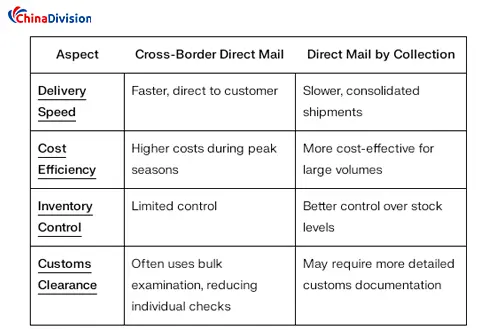Difference Between Cross-border Direct Mail and Direct Mail by Collection
The choice of logistics model is directly related to whether the goods can be delivered to consumers efficiently and safely, which in turn affects the company's operational efficiency and customer satisfaction. Among them, cross-border direct mail (Cross-border Direct Mail) and direct mail by collection (Direct Mail by Collection) are two common logistics models, but they have significant differences in operation procedures, costs, timeliness and applicable scenarios.
Table of Contents
This article will start from the differences between these two models, combine the common pain points of B2B companies, and provide feasible solutions from the perspective of professional fulfillment agent service providers to help you optimize your logistics strategy.
The core difference between cross-border direct mail and direct mail by collection

Cross-border Direct Mail
Cross-border direct mail means that after the seller receives the order, the goods are sent directly from the domestic warehouse or supplier to overseas consumers. This model is usually suitable for small packages and orders with high timeliness requirements, and is common in B2C businesses on cross-border e-commerce platforms. If a single express parcel of cross-border direct mail is sampled, it needs to be unpacked for inspection. If it fails the sample inspection, it will face the risk of return. The cost of cross-border direct mail is usually fixed and paid in advance. This is a comprehensive fee including postage, tariffs and freight.
Because the goods need to pass through multiple different main nodes, it is difficult to determine the responsibility for after-sales problems, so after-sales applications such as return and exchange, refund of shipped goods, etc. are generally not supported. The customs clearance link is the responsibility of domestic express or postal service. If the airport express is used for customs clearance, the four major commercial express companies will declare customs by themselves; if EMS is used for customs clearance, customs clearance can be made through the Universal Postal Union channel or the cooperation of express delivery between the two places. In this mode, there are no customs documents for orders.
Operation process of cross-border direct mail
After the seller receives the overseas order, he will pack and ship it directly.
The goods are transported to the destination by international express, postal parcels, etc.
After customs clearance, they are directly delivered to consumers.
Advantages of cross-border direct mail
Strong timeliness: Since the transit link is omitted, it usually takes only 3-7 days from shipment to delivery, which is suitable for high-value and time-sensitive goods.
Simple operation: no need to prepare goods in advance, reducing inventory pressure.
High flexibility: can deliver goods in real time according to orders, suitable for sellers with a wide range of products and fast updates.
Disadvantages of cross-border direct mail
High cost: International express delivery costs are high, especially for low-value and light-weight goods.
Customs clearance risk: due to direct access to consumers, customs clearance may face a higher inspection rate.
Complex logistics information: sellers need to handle all aspects of international logistics by themselves.
Direct Mail by Collection
Direct Mail by Collection means that sellers send goods to overseas warehouses in batches, and then overseas warehouses sort and deliver them according to orders. This model is common in B2B business or overseas warehouse models of cross-border e-commerce. Some ports may not conduct national entry and exit inspection and quarantine, such as Zhengzhou Port, but overall, goods under the direct mail model still need to go through formal customs clearance procedures.
The cost of direct mail by collection is usually determined after the goods are collected and transported. Companies usually pay according to the volume or weight of the goods, which may fluctuate according to the number of packages transported. After the merchant collects multiple orders of goods, they are transported to the domestic customs supervision warehouse, go through formal customs clearance procedures, and are released after customs inspection. Each order is accompanied by customs documents, and the logistics time is relatively short, usually delivered to consumers within two weeks. In the case of direct mail, the goods are sent to the overseas warehouse in advance, and the return, exchange, and replenishment operations are carried out according to the platform feedback. In this mode, the e-commerce platform can provide a "local return" service, and the overseas team will help consumers to protect their rights.
Operation process of direct mail
The seller sends the goods in batches to overseas warehouses (such as FBA warehouses or self-built overseas warehouses).
Overseas warehouses sort and pack according to orders.
The goods are delivered to consumers through local logistics.
Advantages of direct mail
Low cost: bulk transportation can reduce unit logistics costs.
Strong timeliness: overseas warehouse shipments can be delivered on the same day or the next day, improving customer experience.
Flexible inventory management: inventory can be flexibly adjusted according to market demand.
Disadvantages of direct mail
High initial investment: overseas warehouses need to be rented and inventory management is carried out.
Inventory risk: accurate market demand forecasting is required to avoid backlogs.
Complex operations: involving overseas warehouse management, inventory turnover and other links.
Advantages of international fulfillment service providers
Whether you choose cross-border direct mail or direct mail by collection, it is crucial to choose a suitable international fulfillment service provider. As a professional international fulfillment service provider, Chinadivision has the following advantages:
Extensive global logistics network: ensuring that goods can reach all parts of the world quickly and safely.
Professional customs clearance services: reducing customs clearance barriers and ensuring smooth customs clearance.
Advanced warehouse management system: improving inventory management efficiency and ensuring timely delivery.
Tailor-made logistics solutions: providing the best logistics solutions based on the specific needs of customers.
Cross-border direct mail and direct mail by collection each have their own advantages and disadvantages. Enterprises and sellers need to make choices based on their own business needs. Cross-border direct mail is suitable for high-value goods and urgently needed goods, while direct mail by collection is suitable for large and small batches of goods. When choosing a logistics model, it is crucial to cooperate with a professional international fulfillment service provider. As a professional fulfillment service provider, Chinadivision can provide comprehensive logistics solutions to help companies and sellers improve logistics efficiency, reduce costs, and increase customer satisfaction. If you have any questions about the choice of logistics methods, please contact Chinadivision International Fulfillment Service Provider, and we will provide you with professional answers and services.





